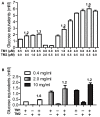Molecular and biochemical analyses of CbCel9A/Cel48A, a highly secreted multi-modular cellulase by Caldicellulosiruptor bescii during growth on crystalline cellulose
- PMID: 24358340
- PMCID: PMC3865294
- DOI: 10.1371/journal.pone.0084172
Molecular and biochemical analyses of CbCel9A/Cel48A, a highly secreted multi-modular cellulase by Caldicellulosiruptor bescii during growth on crystalline cellulose
Abstract
During growth on crystalline cellulose, the thermophilic bacterium Caldicellulosiruptor bescii secretes several cellulose-degrading enzymes. Among these enzymes is CelA (CbCel9A/Cel48A), which is reported as the most highly secreted cellulolytic enzyme in this bacterium. CbCel9A/Cel48A is a large multi-modular polypeptide, composed of an N-terminal catalytic glycoside hydrolase family 9 (GH9) module and a C-terminal GH48 catalytic module that are separated by a family 3c carbohydrate-binding module (CBM3c) and two identical CBM3bs. The wild-type CbCel9A/Cel48A and its truncational mutants were expressed in Bacillus megaterium and Escherichia coli, respectively. The wild-type polypeptide released twice the amount of glucose equivalents from Avicel than its truncational mutant that lacks the GH48 catalytic module. The truncational mutant harboring the GH9 module and the CBM3c was more thermostable than the wild-type protein, likely due to its compact structure. The main hydrolytic activity was present in the GH9 catalytic module, while the truncational mutant containing the GH48 module and the three CBMs was ineffective in degradation of either crystalline or amorphous cellulose. Interestingly, the GH9 and/or GH48 catalytic modules containing the CBM3bs form low-density particles during hydrolysis of crystalline cellulose. Moreover, TM3 (GH9/CBM3c) and TM2 (GH48 with three CBM3 modules) synergistically hydrolyze crystalline cellulose. Deletion of the CBM3bs or mutations that compromised their binding activity suggested that these CBMs are important during hydrolysis of crystalline cellulose. In agreement with this observation, seven of nine genes in a C. bescii gene cluster predicted to encode cellulose-degrading enzymes harbor CBM3bs. Based on our results, we hypothesize that C. bescii uses the GH48 module and the CBM3bs in CbCel9A/Cel48A to destabilize certain regions of crystalline cellulose for attack by the highly active GH9 module and other endoglucanases produced by this hyperthermophilic bacterium.
Conflict of interest statement
Figures







Similar articles
-
The N-Terminal GH10 Domain of a Multimodular Protein from Caldicellulosiruptor bescii Is a Versatile Xylanase/β-Glucanase That Can Degrade Crystalline Cellulose.Appl Environ Microbiol. 2015 Jun;81(11):3823-33. doi: 10.1128/AEM.00432-15. Epub 2015 Mar 27. Appl Environ Microbiol. 2015. PMID: 25819971 Free PMC article.
-
Biochemical and mutational analyses of a multidomain cellulase/mannanase from Caldicellulosiruptor bescii.Appl Environ Microbiol. 2012 Apr;78(7):2230-40. doi: 10.1128/AEM.06814-11. Epub 2012 Jan 13. Appl Environ Microbiol. 2012. PMID: 22247178 Free PMC article.
-
Molecular and biochemical analyses of the GH44 module of CbMan5B/Cel44A, a bifunctional enzyme from the hyperthermophilic bacterium Caldicellulosiruptor bescii.Appl Environ Microbiol. 2012 Oct;78(19):7048-59. doi: 10.1128/AEM.02009-12. Epub 2012 Jul 27. Appl Environ Microbiol. 2012. PMID: 22843537 Free PMC article.
-
Engineering the N-terminal end of CelA results in improved performance and growth of Caldicellulosiruptor bescii on crystalline cellulose.Biotechnol Bioeng. 2017 May;114(5):945-950. doi: 10.1002/bit.26242. Biotechnol Bioeng. 2017. PMID: 28019666
-
Cellulolytic Aerobic Bacteria Isolated from Agricultural and Forest Soils: An Overview.Biology (Basel). 2024 Feb 5;13(2):102. doi: 10.3390/biology13020102. Biology (Basel). 2024. PMID: 38392320 Free PMC article. Review.
Cited by
-
High activity CAZyme cassette for improving biomass degradation in thermophiles.Biotechnol Biofuels. 2018 Feb 1;11:22. doi: 10.1186/s13068-018-1014-2. eCollection 2018. Biotechnol Biofuels. 2018. PMID: 29434665 Free PMC article.
-
Deletion of Caldicellulosiruptor bescii CelA reveals its crucial role in the deconstruction of lignocellulosic biomass.Biotechnol Biofuels. 2014 Oct 9;7(1):142. doi: 10.1186/s13068-014-0142-6. eCollection 2014. Biotechnol Biofuels. 2014. PMID: 25317205 Free PMC article.
-
Two Distinct α-l-Arabinofuranosidases in Caldicellulosiruptor Species Drive Degradation of Arabinose-Based Polysaccharides.Appl Environ Microbiol. 2017 Jun 16;83(13):e00574-17. doi: 10.1128/AEM.00574-17. Print 2017 Jul 1. Appl Environ Microbiol. 2017. PMID: 28432102 Free PMC article.
-
Multidomain, Surface Layer-associated Glycoside Hydrolases Contribute to Plant Polysaccharide Degradation by Caldicellulosiruptor Species.J Biol Chem. 2016 Mar 25;291(13):6732-47. doi: 10.1074/jbc.M115.707810. Epub 2016 Jan 26. J Biol Chem. 2016. PMID: 26814128 Free PMC article.
-
The GH10 and GH48 dual-functional catalytic domains from a multimodular glycoside hydrolase synergize in hydrolyzing both cellulose and xylan.Biotechnol Biofuels. 2019 Dec 3;12:279. doi: 10.1186/s13068-019-1617-2. eCollection 2019. Biotechnol Biofuels. 2019. PMID: 31827607 Free PMC article.
References
-
- Yang SJ, Kataeva I, Hamilton-Brehm SD, Engle NL, Tschaplinski TJ et al. (2009) Efficient degradation of lignocellulosic plant biomass, without pretreatment, by the thermophilic anaerobe "Anaerocellum thermophilum" DSM 6725. Appl Environ Microbiol 75: 4762-4769. doi:10.1128/AEM.00236-09. PubMed: 19465524. - DOI - PMC - PubMed
-
- Blumer-Schuette SE, Lewis DL, Kelly RM (2010) Phylogenetic, microbiological, and glycoside hydrolase diversities within the extremely thermophilic, plant biomass-degrading genus Caldicellulosiruptor . Appl Environ Microbiol 76: 8084-8092. doi:10.1128/AEM.01400-10. PubMed: 20971878. - DOI - PMC - PubMed
Publication types
MeSH terms
Substances
LinkOut - more resources
Full Text Sources
Other Literature Sources

